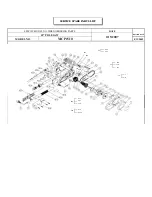
Page 2
For technical questions, please call 1-800-444-3353.
SKU 68819
Save thIS ManuaL
Keep this manual for the safety warnings
and precautions, assembly, operating, inspection,
maintenance and cleaning procedures. Write the
product’s serial number in the back of the manual near
the assembly diagram (or month and year of purchase
if product has no number). Keep this manual and the
receipt in a safe and dry place for future reference.
IMpoRtant SaFetY
InFoRMatIon
In this manual, on the labeling, and all other
information provided with this product:
this is the safety alert symbol. It is
used to alert you to potential personal
injury hazards. obey all safety
messages that follow this symbol
to avoid possible injury or death.
DanGeR indicates a hazardous situation which, if
not avoided, will result in death or serious injury.
WaRnInG indicates a hazardous situation which, if
not avoided, could result in death or serious injury.
CautIon, used with the safety alert symbol,
indicates a hazardous situation which, if not
avoided, could result in minor or moderate injury.
notICe is used to address practices
not related to personal injury.
CautIon, without the safety alert symbol, is used
to address practices not related to personal injury.
General tool Safety Warnings
WaRnInG Read all safety warnings and
instructions. Failure to follow the warnings and
instructions may result in electric shock, fire and/
or serious injury.
Save all warnings and instructions
for future reference.
1.
Keep GuaRDS In pLaCe
and in working order.
2.
ReMove aDJuStInG KeYS anD WRenCheS.
Form habit of checking to see that keys and adjusting
wrenches are removed from tool before turning it on.
3.
Keep WoRK aRea CLean.
Cluttered areas and
benches invite accidents.
4.
Don’t uSe In DanGeRouS envIRonMent.
Don’t use power tools in damp or wet locations, or
expose them to rain. Keep work area well lighted.
5.
Keep ChILDRen aWaY.
All visitors should
be kept safe distance from work area.
6.
MaKe WoRKShop KID pRooF
with padlocks,
master switches, or by removing starter keys.
7.
Don’t FoRCe tooL.
It will do the job better
and safer at the rate for which it was designed.
8.
uSe RIGht tooL.
Don’t force tool or attachment
to do a job for which it was not designed.
tabLe a: ReCoMMenDeD MInIMuM
WIRe GauGe FoR eXtenSIon CoRDS
(120 voLt)
naMepLate
aMpeReS
(at full load)
eXtenSIon CoRD
LenGth
25’
50’ 100’
150’
0 – 6
18
16
16
14
6.1 – 10
18
16
14
12
10.1 – 12
16
16
14
12
12.1 – 16
14
12
Do not use.
9.
uSe pRopeR eXtenSIon CoRD.
Make sure your
extension cord is in good condition. When using
an extension cord, be sure to use one heavy
enough to carry the current your product will
draw. An undersized cord will cause a drop in line
voltage resulting in loss of power and overheating.
Table A shows the correct size to use depending
on cord length and nameplate ampere rating. If
in doubt, use the next heavier gage. The smaller
the gage number, the heavier the cord.
10.
WeaR pRopeR appaReL.
Do not wear loose
clothing, gloves, neckties, rings, bracelets, or
other jewelry which may get caught in moving
parts. Nonslip footwear is recommended.
Wear protective hair covering to contain long hair.
11.
aLWaYS uSe SaFetY GLaSSeS.
Also use face or dust mask if cutting operation
is dusty. Everyday eyeglasses only have impact
resistant lenses, they are NOT safety glasses.
12.
SeCuRe WoRK.
Use clamps or a vise to hold
work when practical. It’s safer than using your
hand and it frees both hands to operate tool.
13.
Don’t oveRReaCh.
Keep proper footing and balance at all times.


































